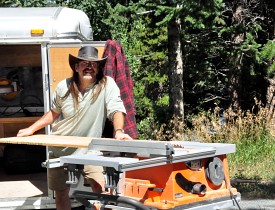Challenges That Exterior Painters Face
 I prefer interior painting work to exterior work hands down. Why, you may ask? Interiors require far less prep, the surfaces are generally flat and you can work without having to deal with weather extremes. Rain, hot weather, dirt, cobwebs and bugs are all challenges to exterior painters.
I prefer interior painting work to exterior work hands down. Why, you may ask? Interiors require far less prep, the surfaces are generally flat and you can work without having to deal with weather extremes. Rain, hot weather, dirt, cobwebs and bugs are all challenges to exterior painters.
Rain is a showstopper and hot is challenging for exterior painters
Nearly all paints these days are latex based and can be cleaned up with water. That means fresh paint and water (aka rain) are a recipe for failure. Painting outdoors requires the surface to be dry before you start but also for sometime afterward. Here in Colorado we get many sunny days, but we also get routine afternoon thunderstorms. Planning around this can be complex for exterior painters, to say the least.
On the other side of the weather coin is hot and dry weather, especially for painters in Dallas and similar climates. You'd think this is great for exterior painters, but 90-100 degree heat is less than ideal. Paint, like most people, prefers indoor temperature and humidity levels. I recently painted some exterior trim while a warm breeze was blowing. Working outside in 90 degree weather is tough, and the breeze felt great, but it adversely affects the paints dry time, and tends to dry the brush out, making cleanup and a smooth finish problematic. Fortunately, in that project I was painting rough cedar so I was not overly challenged with brush marks.
Dirt, cobwebs and bugs
Another challenge for exterior painting contractors is the prep. Very few interior spaces are filled with small piles of dirt, yet this seems to be the norm for every nook and cranny outdoors. Cobwebs and bugs can also be a pain for exterior painters.
On a recent deck project, I needed to reposition some decorative fiberglass columns. In the process, the bases were temporarily lifted and shimmed, which is when I noticed peeling paint along the bottom of the columns. The whole house had recently been spray painted and I wondered how the paint could be failing so soon. When I gently scraped the peeling area, the problem quickly became obvious. All along the corner of these columns, a line of fine dirt had kept the sprayed paint from adhering. If this area had been brushed, it might have worked better, but to get the best results, surfaces being painted need to be very clean. When it came time for me to finish the column bases, I scraped away all the loose paint and then cleaned the nooks and crannies with a damp rag. Once they were dry, I touched up the trouble spots.
It takes a while for paint to dry enough for it to not act like flypaper. While some flies are stronger than others and can sometimes free themselves, those minute gnat-type bugs are doomed. As an exterior painter, I have gotten into the practice of always having a damp rag with me when painting. I normally hold it between my hand and my “handy pail.” When flying pests become unwanted additions to my smooth and flawless paint stokes, I park my brush on the nifty magnet in the handy pail and use my rag to whisk them away. I then quickly touch up the spot. If I’m lucky, I catch the bugs before they are entombed like flies in amber.
Updated October 3, 2018.
Looking for a Pro? Call us (866) 441-6648

Painting Average Costs
Painters Experiences

Interior Paint Job To Prepare For Move-In Day

I Appreciate My Painter For All The Things I DIDN’T Have To Do



